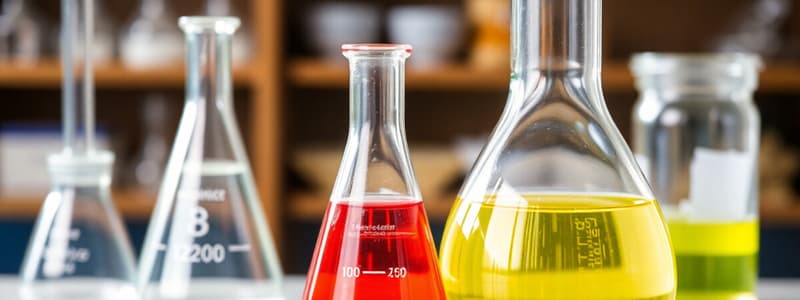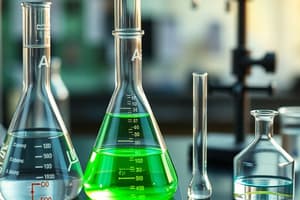Podcast
Questions and Answers
Which term describes a combination of two or more substances that are not chemically combined?
Which term describes a combination of two or more substances that are not chemically combined?
- Mixture (correct)
- Solution
- Compound
- Element
What is the definition of density?
What is the definition of density?
- The size of a three-dimensional space
- The amount of matter in an object
- The gravitational force acting on an object
- The ratio of mass to volume of a substance (correct)
Which of the following substances is considered a pure substance?
Which of the following substances is considered a pure substance?
- Air
- Gold (correct)
- Salt water
- Gatorade
What distinguishes a physical change from a chemical change?
What distinguishes a physical change from a chemical change?
An atom with the same number of protons but a different number of neutrons is called what?
An atom with the same number of protons but a different number of neutrons is called what?
Which type of mixture has materials that can easily be distinguished?
Which type of mixture has materials that can easily be distinguished?
What is the main feature of noble gases?
What is the main feature of noble gases?
Which subatomic particle is found in the nucleus and has a positive charge?
Which subatomic particle is found in the nucleus and has a positive charge?
What is the purpose of significant figures in measurements?
What is the purpose of significant figures in measurements?
Which element group is known for forming salts with most metals?
Which element group is known for forming salts with most metals?
What describes the scientific method?
What describes the scientific method?
What indicates the chemical identity of an element?
What indicates the chemical identity of an element?
What is the main characteristic of plasma as a state of matter?
What is the main characteristic of plasma as a state of matter?
Which best describes a cation?
Which best describes a cation?
Flashcards
Law
Law
A descriptive statement or equation that reliably predicts events under certain conditions.
Technology
Technology
The application of science for practical purposes; the use of tools, machines, materials, and processes to meet human needs.
Theory
Theory
A system of ideas that explains many related observations and is supported by a large body of evidence acquired through scientific investigation.
Mass
Mass
Signup and view all the flashcards
Volume
Volume
Signup and view all the flashcards
Weight
Weight
Signup and view all the flashcards
Length
Length
Signup and view all the flashcards
Scientific Method
Scientific Method
Signup and view all the flashcards
Precision
Precision
Signup and view all the flashcards
Accuracy
Accuracy
Signup and view all the flashcards
Scientific Notation
Scientific Notation
Signup and view all the flashcards
Significant Figures
Significant Figures
Signup and view all the flashcards
Matter
Matter
Signup and view all the flashcards
Element
Element
Signup and view all the flashcards
Atom
Atom
Signup and view all the flashcards
Study Notes
Fundamental Concepts in Chemistry and Physics
- Law: A descriptive statement predicting events under specific conditions.
- Technology: Practical application of science, using tools, machines, and processes to meet human needs.
- Theory: A system explaining multiple observations, supported by evidence from scientific investigation.
- Mass: Amount of matter in an object, unaffected by forces (e.g., gravity).
- Volume: Space occupied by a body or region in three dimensions.
- Weight: Gravitational force acting on an object, varying with location.
- Length: Straight-line distance between two points.
- Scientific Method: Steps used to solve problems – including data collection, hypothesis formation, testing, and conclusions.
- Precision: Exactness of a measurement.
- Accuracy: Closeness of a measurement to the true value.
- Scientific Notation: Expressing a quantity as a number multiplied by a power of 10.
- Significant Figures: Prescribed decimal places determining the degree of rounding based on measurement precision.
- Matter: Anything with mass and occupying space.
- Element: Substance not separable into simpler substances by chemical means; all atoms within an element have the same atomic number.
- Atom: Smallest unit of an element retaining its chemical properties.
- Compound: Substance from two or more different elements bonded chemically.
- Pure Substance: Matter (element or compound) with definite chemical and physical properties.
- Mixture: Two or more substances not chemically combined.
- Homogeneous Mixture: Mixture with uniformly spread substances (cannot be easily distinguished).
- Heterogeneous Mixture: Mixture with distinguishable different materials.
- Density: Ratio of mass to volume (g/cm³ or g/L).
- Physical Change: Changes of form without altering chemical properties.
- Chemical Change: Change forming entirely new substances with different properties.
- Chemical Property: Characteristic indicating a substance's ability to undergo a chemical change.
- Physical Property: Observable characteristic without changing the substance.
- Energy: Capacity to do work.
- Evaporation: Liquid-to-gas state change.
- Condensation: Gas-to-liquid state change.
- Sublimation: Direct solid-to-gas state change (and the reverse process).
- Plasma: State of matter with free-moving ions and electrons. Different properties than solids, liquids, or gases.
- Electron: Subatomic particle with a negative charge.
- Proton: Positive subatomic particle in an atom's nucleus; determines the element's identity (atomic number).
- Neutron: Neutral subatomic particle in an atom's nucleus.
- Atomic Number: Number of protons in an atom's nucleus, defining the element.
- Mass Number: Sum of protons and neutrons in an atom's nucleus.
- Isotope: Atoms with same proton number but different neutron number (same atomic number, different mass).
- Valence Electron: Electron in the outermost shell, determining chemical properties.
- Nucleus: Center of an atom containing protons and neutrons.
- Period: Horizontal row in the periodic table.
- Group: Vertical column in the periodic table, elements share chemical properties.
- Ion: Atom, radical, or molecule with a net positive or negative charge due to electron gain or loss.
- Cation: Positively charged ion (electron loss).
- Anion: Negatively charged ion (electron gain).
- Metal: Shiny element, good conductor of heat and electricity.
- Nonmetal: Poor conductor of heat and electricity, does not form positive ions in solutions.
- Semiconductor: Conducts electricity better than insulators, but less than conductors.
- Alkali Metal: Group 1 elements (Li, Na, K, Rb, Cs, Fr).
- Alkaline Earth Metal: Group 2 elements (Be, Mg, Ca, Sr, Ba, Ra).
- Noble Gas: Group 18 elements; unreactive.
- Transition Metal: Metals utilizing inner electron shells before outer shell for bonding.
- Halogen: Group 17 elements; combining with metals to form salts (Fl, Cl, Br, I, At, Ts).
- Reactant: Substance undergoing chemical reaction.
- Product: Substance produced in a chemical reaction.
- Coefficient: Number before a molecule, indicating amount.
- Subscript: Small number after an element indicating its amount in a substance.
Chemical Reactions and Related Concepts
- Coefficient: The number before a chemical formula specifying the moles of that substance in a chemical reaction.
- Subscript: The small number following an element in a chemical formula specifying the number of atoms of that element within a molecule.
Studying That Suits You
Use AI to generate personalized quizzes and flashcards to suit your learning preferences.
Description
Test your understanding of fundamental concepts in chemistry and physics, including laws, theories, and measurements. This quiz covers essential topics such as mass, volume, and the scientific method, aimed at reinforcing key principles in science. Ideal for students seeking to solidify their grasp on important scientific concepts.




